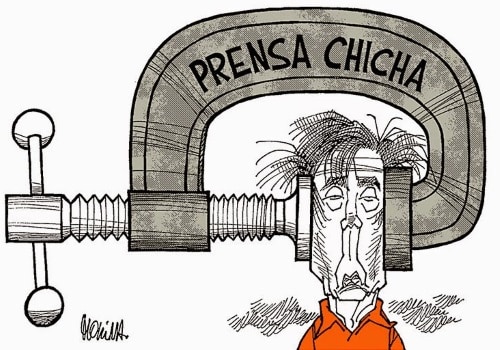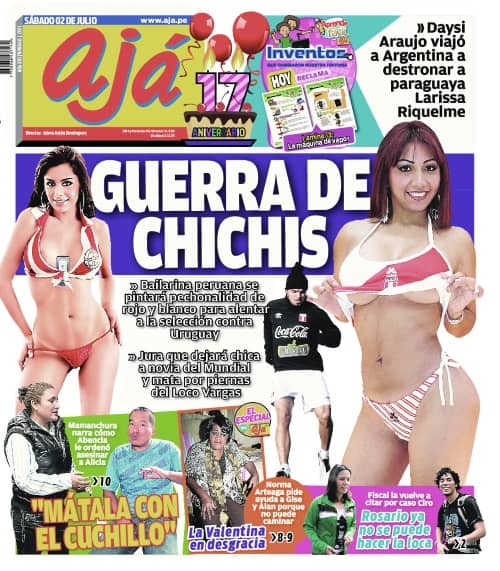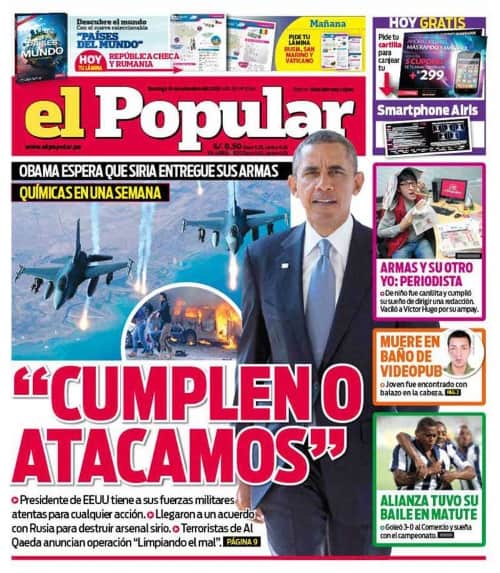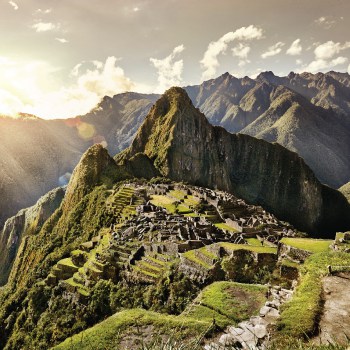The Prensa Chicha: Proudly Printing the Worst Newspapers in Peru

“Prensa Chicha” by cartoonist Mario Molina, published in El Comercio, May 2014
There are some perfectly respectable newspapers in Peru, such as El Comercio, La República, Gestion and the official state daily El Peruano.
But a quick browse through any street-side newspaper stand soon reveals a range of daily newspapers that make the Daily Mail look like the last bastion of brave and serious journalism.
These colorful rags are the newspapers of the prensa chicha (chicha press), the name given to the very worst and most mindless daily publications in Peru.
Why Chicha?
In Peru, the word chicha is most associated with certain corn-based drinks. It was also used to describe a culture that emerged in Lima during the 1960s, a culture built around the customs and music of Andean immigrants coming from the highlands to the capital.
Due to class divides and discrimination against this Andean culture in Lima, the word chicha became associated with more than just a musical style. Certain circles of society — typically non-immigrants — imbued the concept of chicha with negative connotations, including general bad taste and the use of vulgar or derogatory language (“La Prensa Sensacionalista en El Perú”; Chavez Méndez et al).
ENTERTAINMENT TIP: If looking for fun at night, or to watch sports during the day, or even a taste of home, visit the Wild Rover Hostels Chain for great food, sports and beer! Entrance to their bars is free even for non-guests
At the same time, both bad taste and a love for the vulgar were increasingly being embraced by a style of cheap daily newspaper in Lima, one that valued sensationalism above all else and targeted a lower class readership. This sensationalism appealed to the target audience, while the price — about half that of more authoritative daily newspapers — also attracted the poorer sectors of society.
These popular newspapers — defined by a distinct style of shoddy journalism and sensationalist reportage — became known as the prensa chicha.
The Shared Traits of Peru’s Sensationalist Newspapers
Eduardo Quirós Sánchez highlights a number of shared traits of the prensa chicha in his essay “¿Prensa Popular o Prensa Chicha?” These include:
- The name — the name typically has “no relation to the communicative process” and is often based around popular slang. Examples include El Tío, El Chino, El Chato and La Yuca.
- The front page — front page headlines of the prensa chicha use larger lettering than more serious newspapers, as well as brighter colors and more sensationalist images, all to capture the attention visually rather than with any actual content.
- An abundance of celebrity breasts and buttocks — Quirós Sánchez refers to this as vedetismo. In Peru, a vedette is a woman who gains some level of fame by posing for photos in various stages of undress (like the now discarded Page Three Girls in UK tabloid The Sun). They might also be famous for appearing on TV shows etc (including the much-loved and much-derided Esto es Guerra, often cited as a fine example of popular trash TV in Peru). Either way, the prensa chicha appreciates them for their (silicon-enhanced) buttocks rather than for any particular talents or accomplishments.
- Use of slang — chicha newspapers are littered with Peruvian slang, particularly a certain type of slang called replana. This is the street slang used by delinquents and criminals.
- Low price — the low price helps to drive sales among the target audience. Most chicha newspapers are S/.0.50, compared to about S/.1.00 for serious daily newspapers. Quirós Sánchez also notes that chicha newspapers often earn money through sales of dubious adverts, including those offering sexual services (for obvious reasons, serious advertisers don’t like to be associated with the chicha press).
Violence — and violent imagery — is also common in the prensa chicha. Some images are incredibly graphic, showing dead and often mutilated bodies. This, however, isn’t a trait unique to the chicha press. Peruvian TV and newspaper reports often show the deceased victims of traffic accidents, shootings etc. — something that many foreign visitors are not used to seeing in the national press.

The Main Offenders (and Their Respectable Owners)
There’s sometimes a fine line between being simply sensationalist and descending into prensa chicha territory.
Colorful tabloids like Ojo and El Men might argue against the label, while some embrace it wholeheartedly. Daily newspapers that can be considered as chicha include El Chino, Extra, El Popular, Trome and the now defunct Ajá.
And, of course, respectable newspapers like El Comercio and La República would never stoop so low as to be associated with these dubious tabloids.
Or would they? Well, yes, they would. El Comercio, for example, owns the uber-trashy Trome, while La República owns the truly awful El Popular.
And now — for your viewing pleasure — here are some fine examples of Peru’s prensa chicha:

Here Ajá runs a headline that roughly translates as “War of Boobies.” The subheading states that the large breasted woman is showing her pechonalidad, a portmanteau of the words pecho (chest/breast) and personalidad (personality).

Here’s El Popular with a typically dramatic front page featuring Barack Obama and the sensational headline “Comply or We Attack.” There are also jets firing missiles and an image of a burning car, just in case readers weren’t completely convinced about the impending destruction.

Trome leads with “Missiles Against the Crazy Chino.” The “chino” in this case is Kim Jong-un — in Peruvian slang, chino refers to anyone of Asian descent. Trome also refers to Americans as gringos and US troops as “Rambos.” Despite the huge image of a missile launcher, Trome still finds space for a young lady with large breasts.

Speaking of chinos, El Chino really is a fine example of the lowest form of prensa chicha. Here the headline reads “Plague Brings the End of the World.” Apparently “swine flu is the last pandemic of the apocalypse.” Hmm…











2 comments for “The Prensa Chicha: Proudly Printing the Worst Newspapers in Peru”